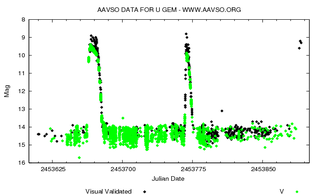
U Geminorum, in the constellation Gemini, is an archetypal example of a dwarf nova. The binary star system consists of a white dwarf closely orbiting a red dwarf. Every few months it undergoes an outburst that greatly increases its brightness. The dwarf nova class of variable stars are often referred to as U Geminorum variables after this star.
Z Andromedae is a binary star system consisting of a red giant and a white dwarf. It is the prototype of a type of cataclysmic variable star known as symbiotic variable stars or simply Z Andromedae variables. The brightness of those stars vary over time, showing a quiescent, more stable phase and then an active one with a more pronounced variability and stronger brightening and/or dimming.
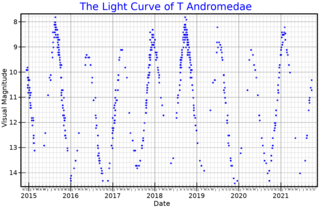
T Andromedae is a variable star of the Mira type in the constellation Andromeda. Like all the stars of this kind, T And is a cool asymptotic giant branch star of spectral type M4e-M7.5e. Its brightness varies periodically, completing a cycle in 281 days. The peak luminosity, however, is different every variability cycle, but can reach a peak magnitude mv=7.70.
AM Canum Venaticorum is a hydrogen-deficient cataclysmic variable binary star in the constellation of Canes Venatici. It is the type star of its class of variables, the AM Canum Venaticorum stars. The system consists of a white dwarf gaining matter via an accretion disk from a semi-degenerate or white dwarf companion.
HD 224801, also known as CG Andromedae, is an Alpha² Canum Venaticorum variable star in the constellation Andromeda. Located approximately 188 parsecs (610 ly) away, the star varies between apparent magnitudes 6.32 and 6.42 over a period of approximately 3.74 days.

WZ Sagittae is a cataclysmic dwarf nova star system in the constellation Sagitta. It consists of a white dwarf primary being orbited by a low mass companion. The white dwarf is about 0.85 solar masses while the companion is only 0.08 solar masses. This implies that the companion is a spectral class L2 star, although this has yet to be confirmed. The distance to this system has been determined by parallax, yielding a distance of 45.1 parsecs.

RX Andromedae is a variable star in the constellation of Andromeda. Although it is classified as a dwarf nova of the Z Camelopardalis (UGZ) type, it has shown low-luminosity periods typical of VY Sculptoris stars. However, for most of the time it varies from an apparent visual magnitude of 15.1 at minimum brightness to a magnitude of 10.2 at maximum brightness, with a period of approximately 13 days.
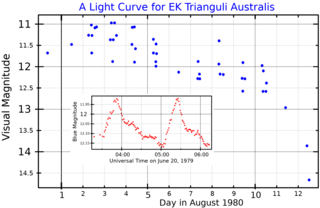
EK Trianguli Australis is a star in the constellation Triangulum Australe. It is a dwarf nova of the SU Ursae Majoris type that officially classified as such in 1980, after the characteristic eruptions of a short eruption and a supereruption were observed in May 1978 and June 1979 respectively. These systems are characterised by frequent eruptions and less frequent supereruptions. The former are smooth, while the latter exhibit short "superhumps" of heightened activity. The distance of the system has been assumed at 180 parsecs from the Solar System, for the donor star. Spectroscopic analysis and calculation gave an estimate of 125 parsecs.

BV Centauri is a cataclysmic variable binary star in the constellation Centaurus. It is a dwarf nova, and undergoes rapid increases in brightness that are recurrent with a mean period of 150 days. This period seems to have increased in the last few decades. During quiescence, its visual apparent magnitude is about 13, with variations of a few tenths of magnitude over an orbit due to differences in the star's visible surface area, brightening to a maximum magnitude of 10.7 during outbursts. From its luminosity, it is estimated that the system is about 500 parsecs (1,600 ly) away from Earth. A Gaia parallax of 2.81 mas has been measured, corresponding to about 360 pc.
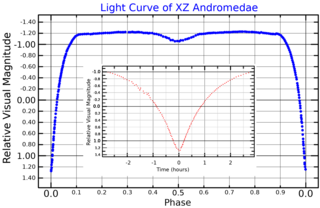
XZ Andromedae is a binary star in the constellation Andromeda. Its maximum apparent visual magnitude is 9.91, but drops down to 12.45 every 1.357 days. Its variability matches the behaviour of Algol variable stars.
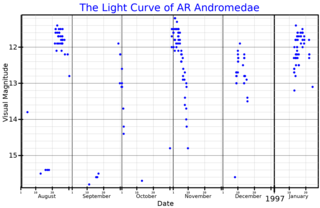
AR Andromedae is a dwarf nova of the SS Cygni type in the constellation Andromeda. Its typical apparent visual magnitude is 17.6, but increases up to 11.0 magnitude during outbursts. The outbursts occur approximately every 23 days.

BM Andromedae is a T Tauri star in the constellation Andromeda. Its apparent visual magnitude has irregular variations between a maximum of 11.63 and a minimum of 14.02.

EU Andromedae is a carbon star in the constellation Andromeda. Its apparent visual magnitude varies in an irregular manner between 10.7 and 11.8.
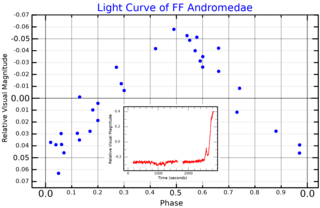
FF Andromedae is a spectroscopic binary in the constellation Andromeda. It has a typical apparent visual magnitude of 10.4, but undergoes flare events that can increase its brightness by about a magnitude.

GR Andromedae is a variable star in the constellation Andromeda. Its apparent visual magnitude varies between 6.87 and 6.95 in a cycle of 518.2 days. It is classified as an α2 Canum Venaticorum variable.

LL Andromedae is a dwarf nova in the constellation Andromeda, discovered during an outburst in 1979. Its typical apparent visual magnitude is 19.4, but undergoes outbursts events when can reach a peak magnitude of 14.3. Since this magnitude is reached during the most powerful outbursts, while less bright outbursts can occur, it is classified as a SU Ursae Majoris variable.

PX Andromedae is an eclipsing cataclysmic variable star in the constellation Andromeda. It has been classified as a SW Sextantis variable, and its apparent visual magnitude varies between 14.04 and 17.

V455 Andromedae is a dwarf nova in the constellation Andromeda. It has a typical apparent visual magnitude of 16.5, but reached a magnitude of 8.5 during the only observed outburst.
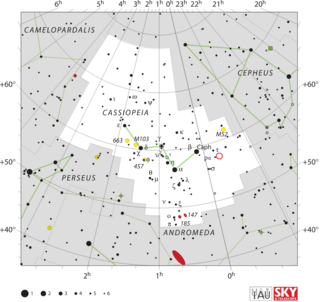
V705 Cassiopeiae, also known as Nova Cassiopeiae 1993 was a nova which erupted in the constellation Cassiopeia during 1993. The nova was discovered at 11:17 UT on 7 December 1993 by amateur astronomer Kazuyoshi Kanatsu of Matsue, Japan, who photographed it using a 35mm camera with a 55mm f/2.8 lens. Asteroid 6976 Kanatsu was named after him in honor of this discovery. At the time of its discovery the nova had a photographic magnitude of 6.5. Around 18 December 1993 it flared briefly to magnitude 5.3, and then it returned rapidly to magnitude 6.5. It underwent a series of smaller flares until mid February 1993, after which it began a precipitous decline in brightness.

OY Arae, also known as Nova Arae 1910, is a nova in the constellation Ara. It was discovered by Williamina Fleming on a Harvard Observatory photographic plate taken on April 4, 1910. At that time it had a magnitude of 6.0, making it faintly visible to the naked eye under ideal observing conditions. Examination of earlier plates showed that before the outburst it was a magnitude 17.5 object, and by March 19, 1910, it had reached magnitude 12.

















